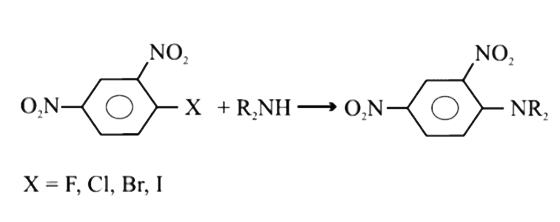In a SN2 substitution reaction of the type
R−Br+Cl−DMF−−→R−Cl+Br+
which one of the following has the highest relative rate?
CH3−CH∣CH3−CH2Br+Cl−
CH3−CH3∣C∣CH3−CH2Br
CH3CH2Br
CH3−CH2−CH2Br
The correct Answer is:C
To determine which compound has the highest relative rate in an SN2 substitution reaction of the type R−Br+Cl−DMF→R−Cl+Br+, we need to consider the structure of the alkyl halide R−Br and how steric hindrance affects the reaction rate.
1. Understanding the SN2 Mechanism:
- In an SN2 reaction, the nucleophile (in this case, Cl−) attacks the carbon atom bonded to the leaving group (here, Br) from the opposite side. This results in a simultaneous bond formation and bond breaking.
2. Identifying the Role of Steric Hindrance:
- The rate of an SN2 reaction is significantly influenced by steric hindrance. The more crowded the carbon atom is (i.e., the more bulky groups attached to it), the slower the reaction will be. This is because the nucleophile has a harder time approaching the carbon atom.
3. Comparing Different Alkyl Halides:
- Let's consider different alkyl halides:
- Primary Alkyl Halide: CH3CH2Br (ethyl bromide)
- Secondary Alkyl Halide: (CH3)2CHBr (isopropyl bromide)
- Tertiary Alkyl Halide: (CH3)3CBr (tert-butyl bromide)
- In these examples, the primary alkyl halide has the least steric hindrance, while the tertiary alkyl halide has the most.
4. Determining the Relative Rates:
- The primary alkyl halide will react the fastest in an SN2 reaction due to minimal steric hindrance. The secondary will be slower, and the tertiary will be the slowest due to significant steric hindrance.
5. Conclusion:
- Therefore, among the options provided, the compound with the least steric hindrance (the primary alkyl halide) will have the highest relative rate in the SN2 reaction.
Final Answer:
The compound with the highest relative rate in the SN2 reaction is the primary alkyl halide (e.g., CH3CH2Br).
- In an SN2 reaction, the nucleophile (in this case, Cl−) attacks the carbon atom bonded to the leaving group (here, Br) from the opposite side. This results in a simultaneous bond formation and bond breaking.
- The rate of an SN2 reaction is significantly influenced by steric hindrance. The more crowded the carbon atom is (i.e., the more bulky groups attached to it), the slower the reaction will be. This is because the nucleophile has a harder time approaching the carbon atom.
- Let's consider different alkyl halides:
- Primary Alkyl Halide: CH3CH2Br (ethyl bromide)
- Secondary Alkyl Halide: (CH3)2CHBr (isopropyl bromide)
- Tertiary Alkyl Halide: (CH3)3CBr (tert-butyl bromide)
- In these examples, the primary alkyl halide has the least steric hindrance, while the tertiary alkyl halide has the most.
- The primary alkyl halide will react the fastest in an SN2 reaction due to minimal steric hindrance. The secondary will be slower, and the tertiary will be the slowest due to significant steric hindrance.
- Therefore, among the options provided, the compound with the least steric hindrance (the primary alkyl halide) will have the highest relative rate in the SN2 reaction.
The compound with the highest relative rate in the SN2 reaction is the primary alkyl halide (e.g., CH3CH2Br).
Topper's Solved these Questions
- BOOK - A2ZCHAPTER - SOME BASIC PRINCIPALS OF ORGANIC CHEMISTRYEXERCISE - AIIMS Questions25videos
SOME BASIC PRINCIPALS OF ORGANIC CHEMISTRY
- BOOK - A2ZCHAPTER - SOME BASIC PRINCIPALS OF ORGANIC CHEMISTRYEXERCISE - Assertion- Reasoning Questions8videos
SOME BASIC PRINCIPALS OF ORGANIC CHEMISTRY
- BOOK - A2ZCHAPTER - SOME BASIC PRINCIPALS OF ORGANIC CHEMISTRYEXERCISE - Section B - Assertion Reasoning25videos
SOME BASIC PRINCIPALS OF ORGANIC CHEMISTRY
- BOOK - A2ZCHAPTER - SOME BASIC CONCEPTS OF CHEMISTRYEXERCISE - Section D - Chapter End Test30videos
SOME BASIC CONCEPTS OF CHEMISTRY
- BOOK - A2ZCHAPTER - STATES OF MATTEREXERCISE - Section D - Chapter End Test30videos
STATES OF MATTER
Similar Questions
Knowledge Check
- Question 1 - Select One
In a SN2 substitution reaction of the type
R−Br+Cl−DMF−−→R−Cl+Br+
which one of the following has the highest relative rate?ACH3−CH3∣C∣CH3−CH2BrBCH3CH2BrCCH3−CH2−CH2BrDCH3−C∣CH3H−CH2Br - Question 2 - Select One
In a SN2 substitution reaction of the type
R−Br+Cl−DMF−−→R−Cl+Br−
Which one of the following has the highest relative rate?A(CH3)3C−CH2BrBCH3CH2BrCCH3CH2CH2BrD(CH3)2CH−CH2Br - Question 3 - Select One
In a SN2 substitution reaction of the type R−Br+Cl−DMF−−→R−Cl+Br−, which of the following has the highest reactivity rate?
ACH3−C∣CH3H−CH2BrBCH3−CH3∣C∣CH3−CH2BrCCH3CH2BrDCH3−CH2−CH2Br
Reaction of ethene with Br2 in CCl4 gives
View SolutionWhich of the following is covelent in nature (X=Cl,Br,I)
View SolutionReaction of ethene with Br2 in CCl4 given :
View SolutionReaction of ethene with Br2 in CCl4 given :
View SolutionConsider the given reaction
RCOOAgBr2/Δ−−−−→R−Br
Which one of the following aicd will give maximum yield of R-Br in the above reaction?View Solution


